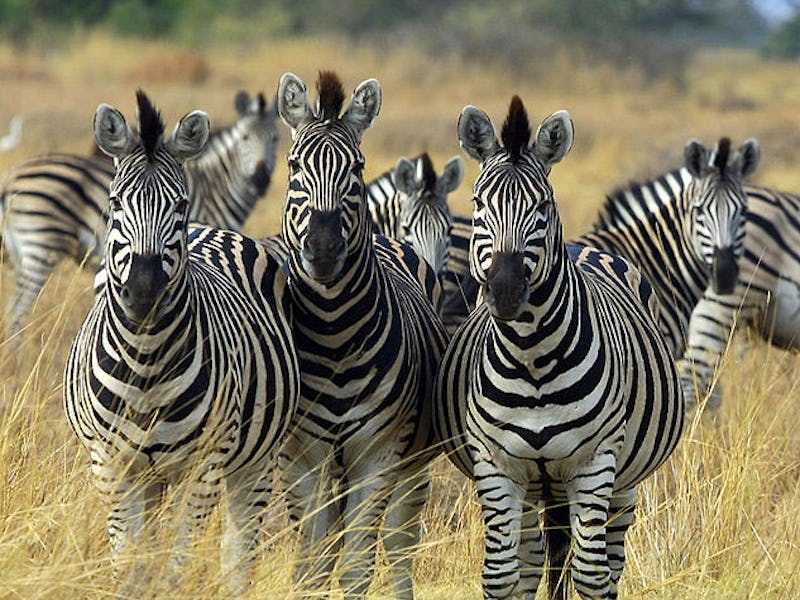Scientists Cross Out One Competing Explanation For Why Zebras Have Stripes
One theory down, 17 to go.

What’s black, white, and a scientific conundrum? To biologists, the answer is zebra stripes. Charles Darwin admitted he was perplexed by the bold pattern in his 1871 treatise The Descent of Man, and today scientists continue to wonder why prey would evolve to stand out in the savanna. Now, scientists have ruled out one of the competing theories behind why zebras have stripes: It is not, as it’s been proposed, to keep themselves cool as a cucumber.
In a study released in the June edition of Scientific Reports, a team of international researchers write that there are as many as 18 theories for the possible functions of zebra stripes.
One theory is that zebras have striped fur to help them stay cool: Because it’s been proven that black stripes get hotter than white stripes, some have proposed that the color variation creates small, cooling vortexes in which the hot air above the black stripes meets the cool air above the white stripes. This process, known as thermoregulation, would look something like this:
Hypothesized cooling by zebra stripes.
“The thermoregulation by use of zebra stripes is one of several interesting theories behind as to why evolved stripes and one which has not been experimentally investigated by measuring core body temperature and the effect of stripes,” study co-author and director of Lund University’s Centre for Animal Movement Research Susanne Åkesson, Ph.D. tells Inverse. “We were interested in investigating how the mechanism may affect the core body temperature of a water-filled barrel imitating a zebra, but also other surface colors, such as black, white, and grey.”
So Åkesson and her team filled up metal barrels with water; covered them with imitation horse, cattle, and zebra hides with various black, white, grey, and striped patterns, and stuck them outside in the open air for four months. Establishing that the barrels covered in stripes shared the same average surface temperature as a living zebra basking in the sun, they consistently measured the core temperatures of each of the barrels throughout the experimental period. To no one’s surprise, at the end of the four months, the barrels that stayed the hottest were the ones covered in black hides, and the ones that stayed coolest were the ones covered in white.
But more importantly, they found that the striped and gray barrels had similar temperatures — meaning that the stripes did not induce the hypothesized cooling effect.
The barrels in question.
“This is a clever first experimental test of the cooling hypothesis for zebra stripes, and their findings do not support the idea that stripes cool the body,” evolutionary behavior professor Ted Stankowich, Ph.D., who was not a part of this study, tells Inverse. He notes that “The idea that stripes cool the body using upwelling and downwelling air streams doesn’t take into account for the frequent movement of the animal, which would certainly disrupt any weak eddies that may form.”
Stankowich says this study’s findings support a different zebra stripes hypothesis that he and other scientists have researched. That explanation says zebra stripes are meant to thwart attacking flies. Åkesson, who has also studied the relationship between striped camouflage and horse-flies, agrees: She too has previously found a direct relationship between stripes and a lack of interest in the flies.
“In previous experiments we have found that the striped pattern substantially reduces the attractiveness to horseflies,” explains Åkesson. “The pattern acts as an optical camouflage, and reduces the risk that the horseflies bite the zebra, in turn reducing the risk to getting a disease transmitted by bloodsucking insects. This theory still holds, and now we may reject the one which suggests stripes were used for thermal regulation.”
There are at least 16 other theories vying for prominence in the great zebra stripes debate. Other researchers, for example, have proposed that these stripes work as motion dazzle patterning, which may confuse and repel predators. According to motion dazzle theory, one zebra may look like bait, but a herd of striped zebras may bamboozle a hungry lion. This theory isn’t foolproof either — in 2016, scientists from the University of California, Davis argued that a hungry lion can still sniff out an equine meal, whether or not stripes are involved.
Still interested in learning about animal camouflage? Then you should watch this video about how climate change may muck the whole thing up: